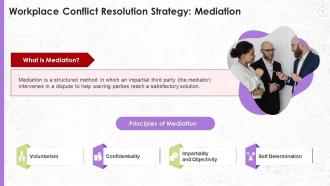Resolving Workplace Conflict With Mediation Training Ppt
This set of slides covers the steps of the mediation process, which are performing preliminary planning and scheduling, greeting parties and discussing the process, understanding perspectives, developing an agenda together, negotiating in good faith, holding private meetings if required, monitoring follow-through, and drafting detailed agreements. It also includes a case study for a better understanding of the concept.
You must be logged in to download this presentation.
 Impress your
Impress your audience
Editable
of Time
PowerPoint presentation slides
Presenting Resolving Workplace Conflict with Mediation. These slides are 100 percent made in PowerPoint and are compatible with all screen types and monitors. They also support Google Slides. Premium Customer Support available. Suitable for use by managers, employees, and organizations. These slides are easily customizable. You can edit the color, text, icon, and font size to suit your requirements.
People who downloaded this PowerPoint presentation also viewed the following :
Content of this Powerpoint Presentation
Slide 1
This slide is a comprehensive, but succinct source of information on mediation, i.e., a structured method in which an impartial third party (the mediator) intervenes in a dispute to help parties to a conflict reach a satisfactory solution. The slide also covers details of multiple principles associated with mediation These are voluntarism, confidentiality, impartiality and objectivity, and self-determination.
Instructor's Notes:
A brief on multiple principles associated with mediation are:
- Voluntarism: The warring parties enter the mediation process according to their own will and have the right to exit the process at any stage or time
- Confidentiality: Any information shared during the mediation process remains confidential, giving employees in conflict the freedom to express themselves without any fear or reservation
- Impartiality and Objectivity: Mediators take a neutral stance to ensure that the mediation process remains impartial and objective
- Self-Determination: In the mediation process, it is the parties to a conflict that reach an agreement. A mediator guides them to a solution with his/her skill in asking the parties to think deeply about solutions
Slide 2
This slide list the responsibilities of a mediator in the mediation process, such as providing impartial support to all parties to the dispute, fostering a safe environment so that both parties can engage in open and honest dialogue and helping parties explore a variety of solutions to reach an agreement to work together.
Slide 3
This slide showcases the multistep mediation process to resolve workplace disputes. The major steps to be executed in order are: preliminary planning, scheduling, and room setup, greet parties and discuss the process, It also involves sharing perspectives, build an agenda together, negotiate in good faith, hold private meetings if necessary, draft agreements with details, and monitor follow-through
Instructor's Notes:
- Step1 - Perform Preliminary Planning and Scheduling: Calling the right people at the right time in the right room is the first step to resolving a workplace conflict. Do research upfront to identify who is involved in a conflict and then create an inviting environment for conflict resolution talks
- Step 2- Greet Parties and Discuss Process: Set ground rules, discuss your role as a neutral facilitator, and assure parties to the conflict that you will help them resolve their differences, and reach an amicable solution
- Step 3 - Understand Perspectives: Neutralize emotional language, reflect and reframe conflict points to demonstrate active listening towards each party's point of view for a better understanding of their respective perspectives
- Step 4 - Develop An Agenda Together: Post-hearing each party's perspective, prepare a cooperative agenda by guiding employees to build a list of topics to be discussed in the conflict resolution meeting
- Step 5 - Negotiate in Good Faith: As a silent player, provide employees the required space to brainstorm and prepare a proposal to create long-lasting and durable solutions
- Step 6 - Hold Private Meetings (If Required): Meeting privately will allow each employee to share sensitive information and ask for what they need. Connecting with both parties independently can help the mediator find common ground around which a consensus can be developed and shared with the disputing parties
- Step 7 - Draft Detailed Agreements: Draft detailed agreements with well-defined roles and responsibilities of each employee ensure that agreed-upon solutions are implemented, with commitment solutions
- Step 8 - Monitor Follow-through: Maintain a follow-through to ensure employees walk the talk on the agreed-upon points of the conflict agreement. Also, check for any signs of brewing resentment and coach employees to resolve issues amicably
Resolving Workplace Conflict With Mediation Training Ppt with all 19 slides:
Use our Resolving Workplace Conflict With Mediation Training Ppt to effectively help you save your valuable time. They are readymade to fit into any presentation structure.
-
The design is very attractive, informative, and eye-catching, with bold colors that stand out against all the basic presentation templates.
-
I am extremely pleased with these PPT slides that we used for our event. They were easy to modify and came out great in all aspects!














































